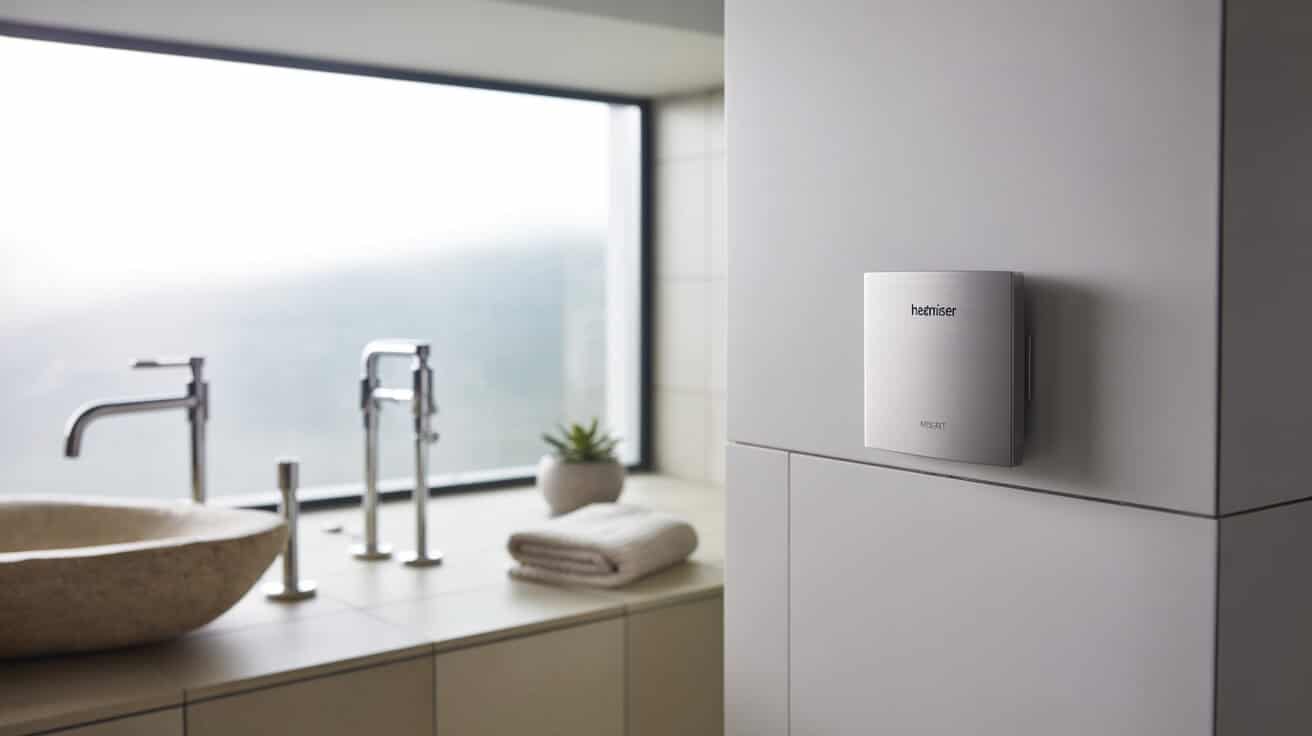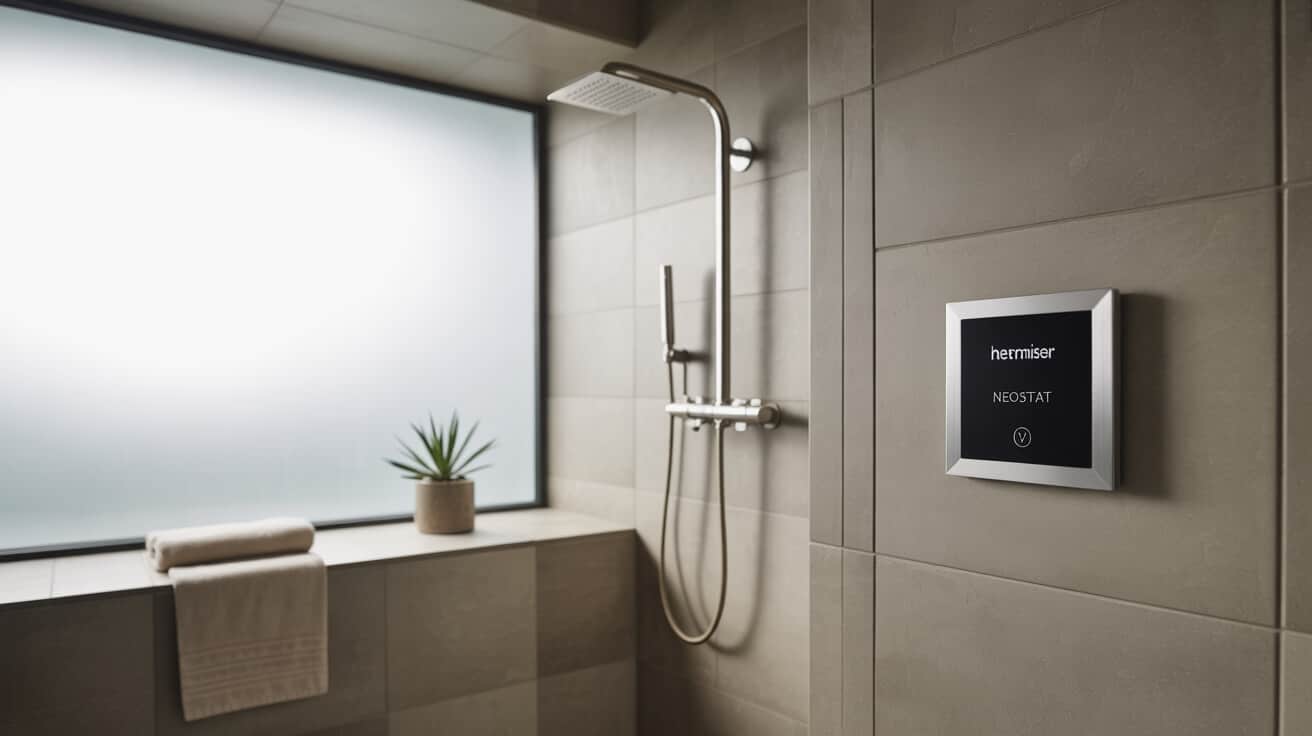Heatmiser NeoStat v2 represents an advanced solution in the evolution of digital heating controls. This smart thermostat leverages dynamic algorithms and sensor data to adjust heating outputs in real time, providing improved comfort and energy efficiency. It has gained widespread use in professional Plumbing & Heating services due to its ability to integrate seamlessly with existing boiler and underfloor heating systems while meeting stringent regulatory standards.
The device’s design underpins a shift toward smarter, more responsive heating control. By automating temperature regulation and supporting remote diagnostics, it helps reduce operating costs and enhances system reliability—a key benefit for both property owners and service providers.
Overview / Context
Heatmiser NeoStat v2 is part of a new generation of smart thermostats that utilise digital technology for adaptive heating control. Its operation hinges on the integration of wireless communication, real-time data monitoring, and sophisticated control algorithms within a broader HVAC ecosystem. In the context of Plumbing & Heating companies, the device serves not only as a control unit but also as part of a comprehensive system that ensures energy efficiency and regulatory compliance.
Technological Landscape
Over the past two decades, thermostat technology has evolved from simple mechanical devices to advanced digital systems. Current smart thermostats, including NeoStat v2, offer robust integration capabilities by connecting seamlessly with other components such as boilers, radiators, and underfloor heating systems. This enhanced connectivity supports:
- Adaptation to environmental changes: Continuous monitoring and data-driven adjustments.
- Energy efficiency improvements: Reduction in wasteful heating through optimised scheduling.
- Remote management: Allowing for rapid diagnostics and adjustments from off-site locations.
Industry Paradigm
The Plumbing & Heating industry has increasingly embraced smart technology, driven by the need to improve energy management and adhere to regulatory standards. Modern systems must balance user comfort with operational efficiency and safety, particularly as regulatory expectations such as WRAS and G3 certification become more rigorous. NeoStat v2 fits within this framework by offering features that facilitate not only optimal household comfort but also proactive facility management for multi-occupancy and commercial environments.
History
The history of heating control technology encompasses a long evolution from early mechanical thermostats to today’s digital solutions. Initially, thermostat systems utilised simple mechanics such as bimetallic strips to control heating, offering only rudimentary control. With advances in electronics and the advent of digital technology, programmable thermostats emerged, providing greater control over heating schedules but with limited adaptability.
Early Developments
In the late 20th century, the introduction of digital thermostats marked the beginning of an era where electronic controls replaced mechanical systems. These early devices improved precision and enabled more sophisticated control strategies, though they generally lacked connectivity and dynamic adaptation features.
Emergence of Smart Controls
The turn of the century brought about significant developments in digital control systems, leading to the emergence of smart thermostats. Research in microprocessors, wireless technology, and networked communication made it possible to develop devices capable of learning from environmental data and user behaviour. The integration of such technologies set the stage for products like Heatmiser NeoStat v2, which combine adaptive scheduling with remote functionality.
Contemporary Evolution
Recent innovations have focused on refining these systems to meet both energy efficiency goals and regulatory requirements. NeoStat v2 has evolved from its predecessors by incorporating advanced sensor technology, enhanced learning algorithms, and improved user interfaces. Its ability to integrate with both new and legacy heating systems has positioned it as a benchmark in smart home technology, reflecting the industry’s push towards digital transformation and sustainable energy management.
Concept / Description
Heatmiser NeoStat v2 is defined by its ability to manage and regulate heating systems through digital intelligence and adaptive control methods. The device is built around a modular platform that incorporates multiple sensors, a control unit, and wireless communication interfaces, enabling it to function as an integral element of a distributed Heating, Ventilation, and Air Conditioning (HVAC) system.
Core Principles
- Adaptive Scheduling: The thermostat utilises historical usage data and ambient sensor inputs to develop efficient heating routines. This dynamic scheduling minimises waste by only providing heating when required.
- Multi-Zone Control: By dividing a property into distinct temperature zones, NeoStat v2 offers personalised comfort settings for different areas, ensuring optimal energy distribution.
- Wireless Connectivity: The system enables remote monitoring and control via mobile applications, allowing installers and end users to adjust the settings in real time.
- Data Integration: Continuous data logging supports performance analysis and predictive maintenance, forming a foundational element of energy management strategies.
Structural Components
The device is composed of several key elements:
- Digital Sensors: These measure temperature, humidity, and other environmental variables to inform control algorithms.
- Control Unit: The central processing module executes adaptive algorithms, integrating sensor data and user inputs.
- User Interface: A clear display offers immediate feedback on settings and system status, designed for ease of use.
- Communication Modules: Wireless transceivers enable network integration, supporting remote diagnostics and system updates.
- Firmware: Regularly updated software ensures compliance with industry standards and allows for continuous improvement of control strategies.
Differentiating Features
Heatmiser NeoStat v2 is distinguished by its robust multi-zone management capability, its integration with both modern and legacy heating systems, and its adherence to strict regulatory requirements such as WRAS, G3 certification, and CP12 compliance. These features make it a versatile and reliable tool for professional service providers in the Plumbing & Heating industry.

Functionality / Purpose / Applications
The primary purpose of Heatmiser NeoStat v2 is to optimise heating performance by providing precise temperature control through advanced digital algorithms. Its functionality extends across various aspects of heating management, catering to a wide range of applications.
Energy Efficiency
The device is engineered to significantly reduce energy wastage:
- Adaptive Algorithms: Continuously adjust heating output based on real-time conditions and historical data.
- Optimised Scheduling: Implements heating cycles that match occupancy patterns, thereby reducing unnecessary energy use.
- Integration with Energy Management Systems: Data-driven insights support proactive adjustments that enhance overall efficiency.
Enhanced Control and Comfort
By managing heating zones discretely, NeoStat v2 enables targeted control:
- Multi-Zone Capability: Allows independent temperature regulation in different areas, ensuring each zone maintains a comfortable environment.
- Responsive Adjustments: Rapid response to environmental changes guarantees stable and precise temperature control.
- User Customization: Tailored control options enable users to set specific schedules and preferences, aligning heating output with daily routines.
Integration with Heating Systems
NeoStat v2 is designed to seamlessly integrate with various heating infrastructure components:
- Boiler Systems: Works in tandem with modern boilers, coordinating with fuel-based heating systems to ensure consistent performance.
- Underfloor Heating: Optimally manages water flow and temperature levels in underfloor systems for improved heat distribution.
- Legacy Systems: Its modular design supports retrofitting challenges, providing a bridge between traditional control systems and modern digital solutions.
Applications
The versatility of Heatmiser NeoStat v2 makes it applicable across multiple contexts:
- Residential Installations: Enhances home heating by providing precise control, thereby improving comfort and energy efficiency in private dwellings.
- Multi-Unit Properties: Facilitates individualised control for landlords and property managers, ensuring that each unit benefits from efficient heating without compromising overall system integrity.
- Commercial Environments: Supports offices, retail spaces, and hospitality setups where maintaining a consistent temperature is key to operations and customer satisfaction.
- Service Provider Use: Plumbing & Heating companies—such as Plumbers 4U—implement the device to standardise installations and deliver reliable, compliant service solutions.
Classifications / Types / Variants
Heatmiser NeoStat v2 is categorised within the broader smart thermostat market. Its classification can be viewed through several lenses:
Feature-Based Classification
Devices in this category differ based on their control features, connectivity options, and learning algorithms. NeoStat v2 is recognised for:
- Advanced Adaptive Scheduling: Outperforming manual and older digital systems through its learning capabilities.
- Multi-Zone Functionality: Allowing differentiated control for diverse spatial needs.
- Remote Diagnostic Abilities: Offering robust connectivity that supports maintenance and real-time adjustments.
System Compatibility
Some smart thermostats are designed solely for new installations, while others may be retrofitted into older system architectures. NeoStat v2 excels in this dual application:
- Retrofit Solutions: Its design accommodates legacy systems, enabling a modern upgrade without extensive reconfiguration.
- New Installations: It is equally effective in complete system overhauls, where it integrates into state-of-the-art digital control ecosystems.
Comparative Positioning
The evolution from traditional thermostats to smart devices has reshaped the heating control landscape. NeoStat v2 is distinguished from conventional models by its digital interface, predictive control mechanisms, and enhanced regulatory compliance:
- Legacy vs. Modern Systems: Traditional devices often lack connectivity and adaptability, whereas NeoStat v2 exhibits dynamic control and seamless integration.
- Generational Improvements: Iterative enhancements in design and functionality have positioned NeoStat v2 as a benchmark against earlier models, underscoring its role in setting new industry standards.
Systems / Tools / Methodologies
Heatmiser NeoStat v2 is deployed as part of a larger ecosystem within Plumbing & Heating systems. Various methodologies and tools support its effective use, ensuring that system integration and ongoing maintenance are conducted in line with best practices.
Installation Methodologies
Professional installation of NeoStat v2 follows standardised protocols:
- Pre-Installation Assessments: Detailed evaluation of the existing heating system ensures that the device is compatible with the current infrastructure.
- Calibration Procedures: Technicians use advanced digital tools such as thermal imaging cameras and pressure gauges to calibrate the system accurately.
- Compliance Verification: Installation processes incorporate regulatory checkpoints to ensure adherence to standards such as WRAS, G3, and CP12.
Diagnostic and Monitoring Tools
The thermostat is equipped with multiple diagnostic features:
- Sensor Networks: Continuous monitoring of environmental parameters via digital sensors supports robust system management.
- Data Logging and Analysis: Real-time data collection facilitates performance tracking over time, enabling proactive maintenance.
- Remote Troubleshooting: Wireless connectivity allows technicians to perform diagnostics and adjustments remotely, streamlining the maintenance workflow.
Energy Management Strategies
Heatmiser NeoStat v2 plays a pivotal role in the broader energy management landscape:
- Adaptive Control Algorithms: The device adjusts heating output dynamically based on ambient conditions and user behaviour, promoting energy conservation.
- Multi-Zone Distribution: By dividing heating systems into independent zones, operators can optimise energy distribution to meet specific area requirements.
- Performance Benchmarking: Continuous data collection provides a basis for comparing system performance against industry standards, assisting in long-term energy management planning.
Methodological Rigour in Support Processes
Quality assurance methods are integral to the device’s deployment:
- Systematic Testing: Both pre- and post-installation tests ascertain the device’s functional integrity and ensure it meets performance benchmarks.
- Maintenance Protocols: Scheduled servicing, firmware updates, and calibration checks are enforced as part of routine system maintenance.
- Regulatory Adaptation: The system is designed to evolve in accordance with advancing regulations, ensuring ongoing compliance and operational safety.
Stakeholders / Entities Involved
The deployment and use of Heatmiser NeoStat v2 involve a range of stakeholders whose interests span technical, regulatory, and operational domains.
Service Providers
Plumbing & Heating companies—such as Plumbers 4U—employ the device to enhance the consistency and quality of their service offerings. Their responsibilities include:
- Installation and Calibration: Ensuring that the system is installed according to regulatory guidelines and accurately calibrated.
- Maintenance and Support: Providing ongoing servicing to address any operational issues, thereby sustaining high performance.
- Customer Communication: Offering clear, documented explanations of system functionality and regulatory compliance to end users.
Technical Professionals
Technicians and installers are critical in executing system setups and modifications:
- Certification and Training: Professionals are typically certified in industry standards (e.g., WRAS, G3, CP12) and receive specialised training in digital control system installation.
- Diagnostic Expertise: Their ability to troubleshoot and optimise the system based on sensor data and performance metrics is essential for long-term reliability.
- System Oversight: They are responsible for managing data streams, analysing performance logs, and ensuring that system adjustments occur as intended.
End Users
End users, including homeowners, landlords, property managers, and commercial facility operators, experience the tangible benefits of the device:
- Residential Benefits: Homeowners enjoy improved comfort and energy savings through precise temperature control.
- Property Management: Landlords and managers gain a tool for efficiently managing complex, multi-unit heating systems while complying with safety regulations.
- Commercial Applications: Businesses benefit from consistent temperature regulation and reduced energy costs, which contribute to a stable and cost-effective operating environment.
Regulatory and Certification Bodies
The design and deployment of Heatmiser NeoStat v2 are driven by adherence to key regulatory requirements:
- Regulatory Authorities: Agencies enforcing WRAS, G3, CP12, and EPC standards influence both the design and operational parameters of the device.
- Certification Organisations: Bodies such as the Gas Safe Register and Energy Saving Trust provide independent validation of the system’s safety, efficiency, and performance.
- Industry Associations: Organisations like CIPHE and BESA facilitate knowledge sharing, standardisation, and continuous improvement within the Plumbing & Heating domain.

Legal / Regulatory / Ethical Considerations
Heatmiser NeoStat v2 is developed and installed in accordance with comprehensive legal and regulatory frameworks that ensure safety, performance, and consumer protection.
Compliance Standards
- WRAS Approval: The device meets the stringent criteria established by the Water Regulations Advisory Scheme, which governs standards in water supply and waste management.
- G3 Certification: Critical for unvented hot water systems, this certification ensures that the system adheres to specifically defined safety parameters.
- CP12 Gas Safety Requirements: For installations that involve gas appliances, maintaining CP12 compliance is essential to safeguard user safety and meet legal obligations.
- EPC Contributions: The use of advanced control systems like NeoStat v2 contributes to higher Energy Performance Certificate ratings by optimising energy usage at the building level.
Ethical Guidelines
- Transparent Practices: The system is installed following standard ethical guidelines, ensuring that consumers receive clear and accurate information regarding the installation process and ongoing maintenance.
- Consumer Protection: Strict adherence to safety standards protects consumers from potential hazards related to improper installation or maintenance.
- Sustainability Considerations: The emphasis on energy efficiency aligns with broader environmental goals, promoting sustainable energy consumption and reducing carbon footprints.
Regulatory Integration
Compliance is maintained through rigorous quality assurance:
- Regular Audits: Service providers conduct periodic audits to ensure that installations continue to meet regulatory standards.
- Documentation: Detailed records are kept for each installation, verifying adherence to industry standards and facilitating future maintenance.
- Ongoing Updates: Firmware and operational protocols are updated in response to changes in regulations, ensuring

